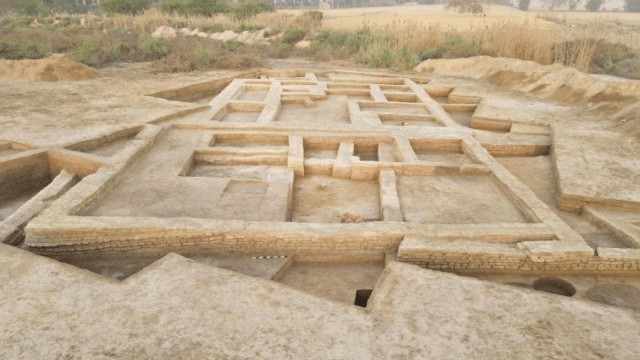Mitathal and Tighrana: Newly Protected Harappan Sites in Haryana

- 05 Apr 2025
In News:
The Haryana Government has declared Mitathal and Tighrana, two historically significant Harappan civilisation sites in Bhiwani district, as protected archaeological sites under the Haryana Ancient and Historical Monuments and Archaeological Sites and Remains Act, 1964.
Location and Legal Status
- Both sites are located in Mitathal and Tighrana villages of Bhiwani district, Haryana.
- The notification was issued on March 13, 2025, designating a 10-acre area at Mitathal for protection.
- The Heritage and Tourism Department will ensure preservation through site fencing and deployment of guards.
Mitathal Site: Key Highlights
- Period: Dates to the Copper-Bronze Age, roughly 3rd to 2nd millennium BCE.
- Archaeological Finds:
- Well-baked red pottery with black painted motifs like pipal leaves and fish scales.
- Beads, copper tools, bangles, terracotta, and bone artefacts.
- Historical Timeline:
- First identified in 1913 through Samudragupta coins.
- Systematic excavations began in 1965–68 and continued post-2016 by the Central University of Haryana.
- Cultural Features:
- Reflects urban planning and craftsmanship typical of the Harappan Civilization.
Tighrana Site: Cultural Significance
- Chronology: Rich in pre-Harappan, Harappan, and post-Harappan layers.
- Inhabitants: Associated with Sothian culture – early Chalcolithic farming communities (~2400 BCE).
- Settlement Traits:
- Mud-brick houses, some possibly fortified.
- Use of bichrome wheel-made pottery (black and white designs).
- Artefacts:Green carnelian bangles, beads, and tools suggest a thriving bead and jewellery industry.
Archaeological and Cultural Importance
- Continuity of Settlement: Offers insight into continuous human occupation from Pre-Siswal to Post-Harappan periods.
- Socio-economic Insights:Demonstrates early agricultural practices, urban planning, and craft traditions in the Indo-Gangetic divide.
Background: Harappan Civilization
- Also known as the Indus Valley Civilization (IVC); flourished around 2500 BCE.
- One of the world’s oldest urban civilizations, alongside Mesopotamia, Egypt, and China.
- Classified as Bronze Age due to artefacts made from copper-based alloys.
- Key excavations:
- Harappa (1921–22) by Daya Ram Sahni.
- Mohenjo-daro (1922) by R.D. Banerji, under supervision of Sir John Marshall (ASI).
